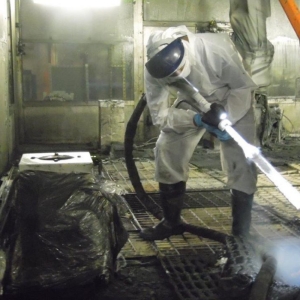The Science Behind Dry Ice Blasting: Unveiling The Power, Precision, And Eco-Friendly EdgePosted by Kyle Webster on February 2nd, 2024  In the world of industrial cleaning, one method stands out for its efficiency, precision, and environmentally friendly nature – dry ice blasting. This cutting-edge technology has gained popularity across various industries, from manufacturing and automotive to food processing and aerospace. In this blog post, we'll delve into the science behind dry ice blasting, exploring how it works and why it has become an effective and sustainable solution for industrial cleaning needs. UNDERSTANDING THE BASICS OF DRY ICE BLASTINGStarting with the sublimation process, dry ice blasting involves the use of solid carbon dioxide (CO2) pellets as the blasting media. Unlike traditional blasting methods that use abrasive materials, dry ice pellets undergo sublimation when they come into contact with the surface to be cleaned. Sublimation is the process by which a substance transitions directly from a solid to a gas without passing through the liquid phase. In the case of dry ice, this sublimation releases kinetic energy, creating a powerful cleaning force. No Residue Left Behind! One of the key advantages of dry ice blasting is that it leaves no secondary waste. As the dry ice pellets sublimate into CO2 gas upon impact, there is no residue left behind to be cleaned up. This feature makes dry ice blasting an environmentally friendly option, eliminating the need for additional cleanup and reducing overall waste generation. THE MECHANISM OF DRY ICE BLASTING
ADVANTAGES OF DRY ICE BLASTINGNon-Abrasive in Nature compared to traditional abrasive blasting methods that can wear down and damage surfaces over time. Dry ice blasting, being non-abrasive, eliminates the risk of substrate damage. This is particularly beneficial for industries such as aerospace and automotive manufacturing, where delicate components and precision surfaces require careful cleaning. No Water or Chemicals Required during the process. Dry ice blasting is a dry process that doesn't use water or chemicals as cleaning agents. This feature makes it an attractive option for industries looking to minimize water usage and avoid the use of chemical cleaning agents. The absence of water also means that there is no risk of corrosion to sensitive equipment or surfaces. Reduced Downtime mean back to production in a timely manner. The efficiency of dry ice blasting Michigan translates into reduced downtime for industrial facilities. Since there is no need for drying time or secondary cleanup, production can resume quickly after the cleaning process. This is a crucial factor for industries where minimizing downtime is essential for maintaining productivity and profitability. APPLICATIONS OF DRY ICE BLASTING
ENVIRONMENTAL SUSTAINABILITY
CHALLENGES AND CONSIDERATIONSWhile dry ice blasting offers numerous advantages, it's essential to consider the initial investment and operating costs associated with the technology. However, many industries find that the long-term benefits, including reduced downtime and maintenance costs, outweigh the initial expenses. Effective implementation of dry ice blasting requires trained personnel who understand the intricacies of the technology. Investing in proper training ensures that operators can maximize the benefits of dry ice blasting while minimizing the risk of operational errors. SUCCESS STORIES WITH DRY ICE BLASTINGAerospace Component Cleaning: In the aerospace industry, where precision and cleanliness are paramount, dry ice blasting has proven to be an invaluable tool. Case studies reveal successful applications in cleaning intricate components, such as turbine blades and aircraft engines, without causing damage or leaving residue. Automotive Paint Line Cleaning: Automotive manufacturing facilities have adopted dry ice blasting for the cleaning of paint lines and booths. The non-abrasive nature of dry ice blasting ensures that delicate paint surfaces remain intact while contaminants are efficiently removed, improving the overall quality of the painting process.
CONCLUSION ON THE SCIENCE BEHIND DRY ICE BLASTING: UNVEILING THE POWER, PRECISION, AND ECO-FRIENDLY EDGEThe science behind dry ice blasting unveils a revolutionary approach to industrial cleaning services Michigan, combining the power of kinetic energy and micro-thermal shock with environmental sustainability. From its non-abrasive nature to its ability to reduce downtime and comply with stringent regulations, dry ice blasting has become a go-to solution for industries seeking efficiency and eco-friendliness. As the technology continues to evolve and find new applications, the future of industrial cleaning looks increasingly promising, with dry ice blasting at the forefront of innovation and environmental responsibility. Like it? Share it!More by this author |


